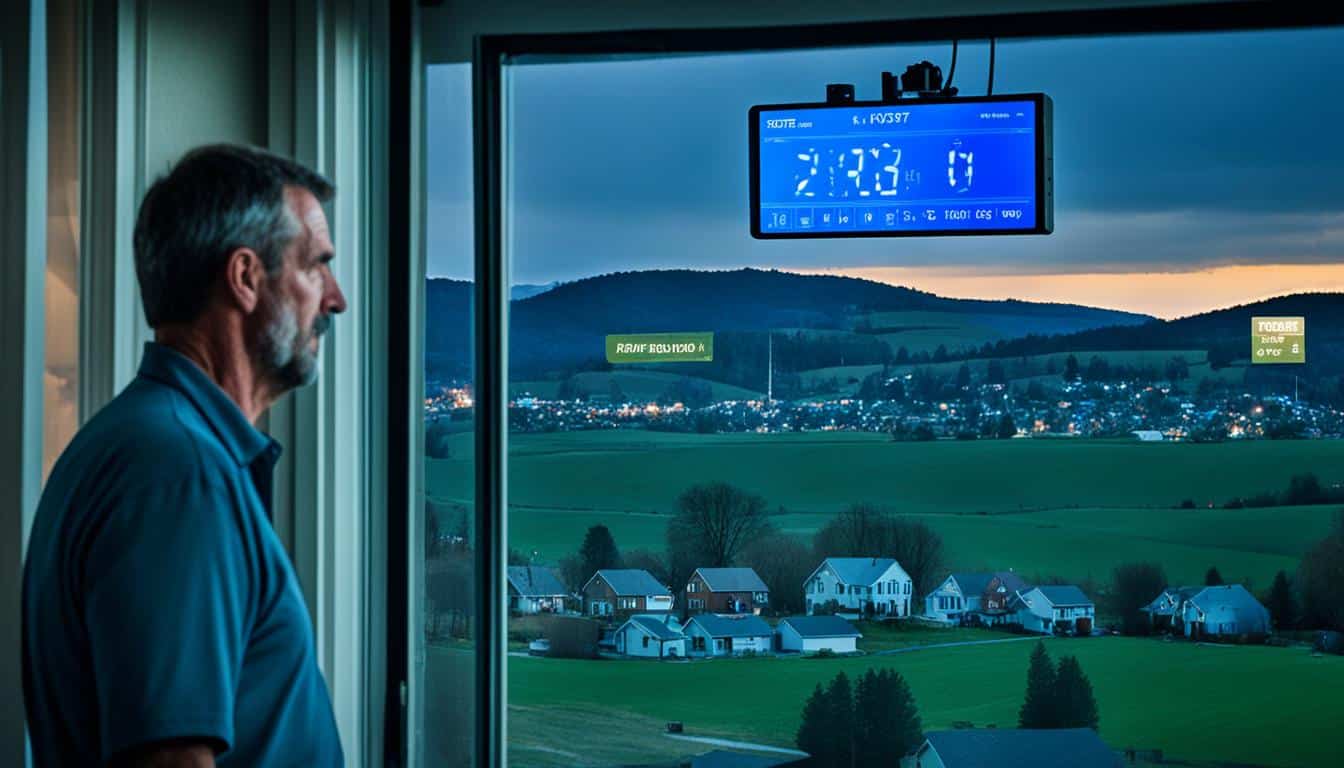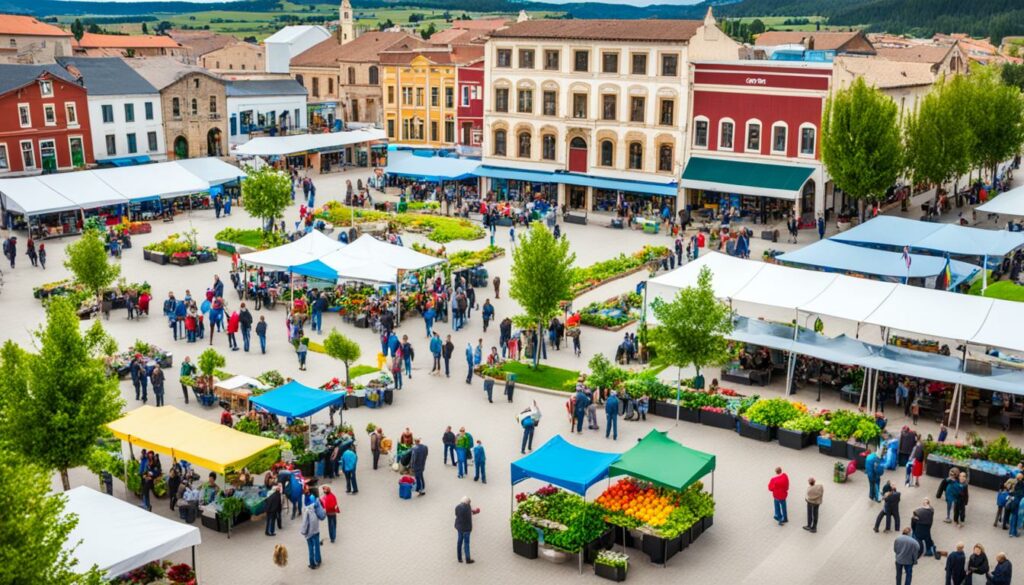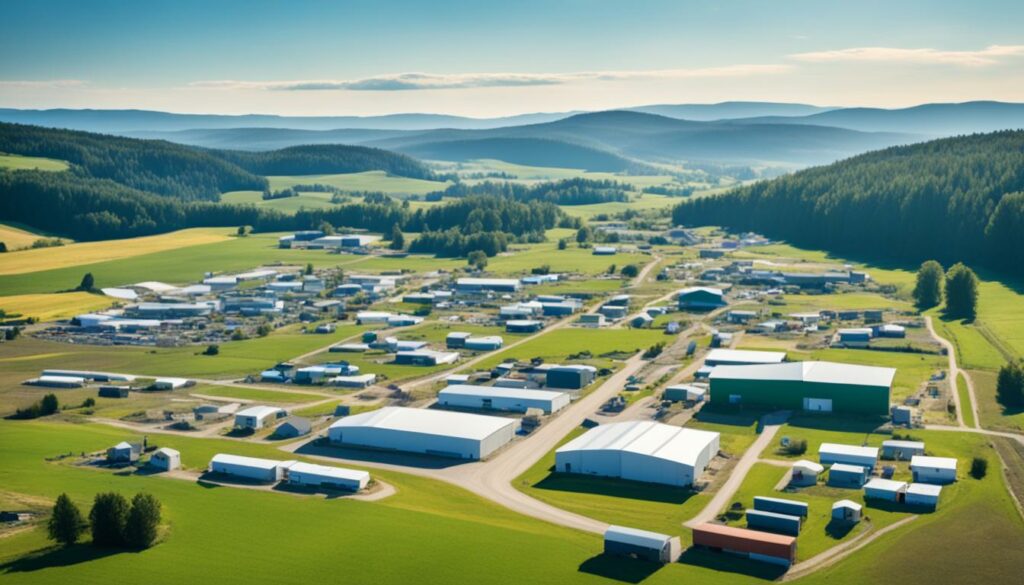Menu

Did you know that between rural and urban areas in the United States, a gap in internet use existed up to 2015? This gap is called the digital divide in rural areas. It affects millions, keeping them from fair access to technology. In 2015, 69% of rural people used the internet, but 75% of city folks did. This lack of access affects education and the economy in rural areas.
Bridging the digital divide in rural areas needs focused efforts. It’s important that rural places get the same tech benefits as cities. The digital gap seriously affects growth and daily life in the countryside.
The status of internet connectivity in rural regions is a big contrast to city areas. While some progress has been made, there are still major challenges. For example, 72% of rural Americans now have broadband at home, up by nine points from 2016. But, this is still less than what urban areas have.
In terms of devices, rural folks have fewer smartphones, tablets, or computers compared to those in the suburbs. Just 30% of them have multiple devices for internet access. This is much lower than the 43-44% in urban and suburban areas. So, rural areas are slower to adopt technology.
When it comes to daily internet use, only eight-in-ten rural adults use the internet daily. This is less than the nine-in-ten urban adults. Also, more rural adults are worried about having enough internet speed. 24% think it’s a big issue, compared to urban and suburban areas at 13% and 9%.
Looking at infrastructure, in 2018, only 51.6% of rural residents had access to fast internet. This is a lot lower than the 94% in urban areas. Homes with slow speeds can’t have many devices using the internet at once. This makes the technology gap in the countryside worse.
There are also economic disparities in internet access. 40% of those making less than $25,000 a year don’t have high-speed internet. And, different groups have different access. 34% of American Indian rural households lack broadband, while it’s 21% for white rural households. This unequal broadband access makes improving internet connectivity in rural regions a major challenge.
There has been a big gap in internet use between rural and urban areas for a long time. Since 1998, data from groups like NTIA and Pew Research shows this. Although more people in both places use the internet now, there’s still a difference of 6-9%.

Things have changed, but the gap is still there. In 2021, 81% of rural homes could access broadband, but this was 86% in cities. People in the countryside, especially those with less money and education, find it hard to use the internet more.
Reasons like not needing it and high costs keep many from getting broadband. 58% say they don’t need it and 18% find it too expensive. This stops people from connecting even when they can.
Pew Research explains that lots of folks in the countryside don’t have home broadband. About 27% only use the internet on their phones. Meanwhile, wealthier city areas get much better internet; up to 100 Mbps faster. This creates a big difference in what people can do online.
In Pennsylvania, over 330,000 places don’t have good internet. 26% of these are rural, but 81% of those without good internet live in the countryside. This shows the big problem rural areas face.
Big efforts to help, like the American Rescue Plan Act, have come. However, many problems remain. One is not having enough people who can set up this new infrastructure. Then, there are long waits to get trained and rules that make it hard to use the money meant to help. To really make a difference, communities, governments, and internet companies need to work together.
The digital divide in rural areas comes from many factors. Things like not having enough money and living in isolated places make it hard. It’s important to look at these reasons to fix the problem of not everyone having access to technology.
Poor families and those living in the countryside often struggle to get online. In 2021, the Census Bureau found that 81% of rural homes had internet, compared to 86% in cities. But, there are about 24 million households that don’t use the internet. Over half of them say they don’t need it, or it’s too expensive.
Places like Staunton show how hard it can be. There, many people live in poverty, and they don’t see the point of getting online because of the cost. This lack of internet makes life even more challenging for them.
Living far from services affects whether you can get online. Areas with few people find it tough to set up internet service. The FCC says it would take $40 billion to get broadband to almost everyone. This means a huge investment is needed to make it happen.
Often, private companies choose to help in ways that make them the most money. This means rural places can miss out. Right now, 55 million Americans don’t have broadband, with 14 million being in the countryside. This problem stops rural people from joining the rest of the world online.
| Statistic | Urban Areas | Rural Areas |
|---|---|---|
| Households plugged into broadband | 86% | 81% |
| Individuals lacking access to broadband connection | 41 million | 14 million |
| Main reasons for not using internet at home | 24% | 42% |
| Cost being too high | 12% | 18% |
The digital divide hits rural areas hard, affecting important aspects of life. It’s especially tough in places like Staunton, Virginia, where almost 12% live in poverty. With limited internet, these areas miss out on key chances for growth.

Having internet in rural spots is key for economic growth. But, 14 million folks in rural America lack this vital connection. Without it, businesses there can’t easily expand. In Staunton, incomes show a clear need for better opportunities. To fix this for most of the US, the FCC says $40 billion is a must.
Still, Wood says the high cost keeps companies from helping out. This also slows down rural areas’ economic progress. Even with 55 million Americans lacking internet, mixing public and private efforts is crucial for change.
Education in rural spots often depends on the web now. Staunton, for example, sees 16% of its young and 11% of its old facing poverty. But, without good access, getting ahead education-wise is tough. The internet is a must-have nowadays, and rural areas missing out fall back even more.
Without broadband, students and those eager to learn more struggle. This digital gap holds rural areas back, making their future chances worse.
For more insights on bridging these disparities, explore resources on closing the digital and economic divides.
| Statistic | Data |
|---|---|
| Population of Staunton, VA (2017) | 25,000 |
| Poverty Rate in Staunton | Nearly 12% |
| Cost to Improve Broadband Access Nationwide | $40 billion |
| Population Lacking Broadband | 55 million (14 million in rural areas) |
| Median Income in Staunton | Nearly $33,000 |
| Per Capita Income in Staunton | Slightly over $19,000 |
The digital gap is a big issue in rural places. It affects the economy and how people connect. To fix this, both government and local efforts work together. They provide better internet and teach people how to use it.
Government projects help spread internet in rural spots. BroadbandUSA is one example. It offers help and money to make the internet reach more places. These efforts help people get online to learn, get jobs, and find healthcare.
But, local efforts are also important. They meet the specific needs of people in each area. These projects focus on teaching about the internet, fixing tech problems, and using local culture. By working with leaders and the community, these projects make lasting changes.
| Region | Internet Penetration | Challenges | Initiatives |
|---|---|---|---|
| Africa | 2.64 IDI (2017) | Low ICT Development Index | Community-based digital literacy programmes |
| Latin America & Caribbean | Steady growth | Geographical barriers | Expanded mobile usage |
| China (2003) | 600,000 rural users | Urban-rural digital gap | Provincial broadband expansion |
Together, government and local work is key. This teamwork helps smooth out the digital gap. It makes sure everyone has a fair chance to go online.
Many rural broadband projects have launched to tackle the digital divide in the countryside. They aim to boost internet access and technology use for everyone, including different kinds of people.

Yet, not all areas have seen the same results from these efforts. Rural homes are less likely to have a broadband connection than those in towns or cities. This difference is especially clear among certain groups. For example, fewer American Indian and Black families have broadband compared to white families.
Over 2.7 million rural homes still don’t subscribe to internet services. For many, the high cost is a big barrier. This issue affects things like job opportunities and children’s education. During the COVID-19 pandemic, many rural students struggled with their online lessons because of bad internet access.
The rural broadband initiatives have helped, but there are big challenges. For instance, building the necessary internet infrastructure remains tough. Also, there are many laws in the U.S. that stop towns and cities from setting up their own broadband networks. Even though billions of dollars have been put into broadband, progress is slow.
| Statistic | Rural Areas | Non-Rural Areas |
|---|---|---|
| Broadband Connection | 61.9% | 77.6% |
| No Internet Subscription | 20% | 12% |
| Poverty Rate (2019) | 15.4% | 11.9% |
Improving current barriers is key to these projects’ success. Using fibre optic technology can help reach more people with better internet. This is important for growing the economy and making education more accessible.
While these rural broadband initiatives have definitely helped, more work is needed. Better support from the government and improved laws are crucial. We must keep working to close the digital gap in rural areas.
Getting high-speed internet in rural parts needs a team effort. Public and private groups working together is key. They help tackle big issues and get internet out to faraway places.
In places like Vermont and Pennsylvania, partnerships have made a big difference. ECFiber in Vermont shows how it’s done. It used a mix of government and private funds to bring fast internet to rural areas.
And in Pennsylvania, local leaders joined forces. They used public-private teamwork to link people in remote areas to the web. These efforts have shown what can be achieved when everyone works together.
As we look ahead, more teamwork is needed. With help from government and private sector money, more difficult rural broadband issues can be fixed. Funding from sources like the Infrastructure Investment and Jobs Act can make a big difference if used well.
This future effort will include many groups. Local authorities, community groups, and electric co-ops will all play a key part. By coming together, they can make sure more rural areas get the internet access they need.
Young people are moving to big cities for more job and life opportunities. This move leads to smaller towns losing people and facing money problems. It’s very important to bring *new technology* to these areas to close the gap with big cities. By using special projects with money from local and national governments, places can get more internet. This can help in many ways, like making education better, bringing in more tourists, making health services more available, and creating new jobs.

*Satellite internet* is a key method to bring the internet to hard-to-reach spots. Current broadband needs a lot of cables and towers, which can’t always be put in these areas. But, with *satellite internet*, it becomes much simpler to connect places not close to cities. This method supports farmers, local shops, and health services, which can then help improve the area’s economy. Luckily, technology is improving to make this type of internet faster and more reliable for everyone in the countryside.
5G is a big deal for improving rural internet. It’s not just about speed; it allows for better farming, learning at a distance, and health services. For farming, drones and GPS can use 5G to plan better and use resources smarter. Combining 5G with edge computing means less waiting for internet data. This quick data is essential for things like watching over farms or online doctor visits, where every second counts.
| Technological Innovation | Benefits |
|---|---|
| Satellite Internet | Wider coverage, improved access to telehealth and education, enhanced local business opportunities |
| 5G Networks | Higher speeds, support for precision agriculture, real-time applications through edge computing |
Bringing in new tech, like *satellite internet* and 5G, can change rural places a lot. It can bridge the gap with cities, grow the economy, and make life better for the people there.
Bringing technology to rural areas is tricky. This is mainly due to geographical challenges. The lack of good roads and the tough land make setting up internet hard. This slows things down and makes it cost more.
“The lack of Internet access in rural areas is hindering technological transformation and leaving rural communities behind in the digital age.”
One big problem is the cost. It’s a lot of money to spread internet out over big, empty places. This puts off companies from investing in these areas. So, rural places miss out on tech that could really help them.
But, it’s not just about money. It’s also about fitting technology to what people need. For example, farmers might need special tools to work their fields more efficiently. These must work well with what they already do.
Yet, there are benefits to be had. If rural areas can get more tech, it could boost their economies. Plus, people would have easier access to things like online shopping and medical services.
The key challenge is finding ways to make technology work well in the countryside. It must be both practical and something that will last. This is tough but very important.
Digital literacy is key to fighting the digital divide, especially in rural areas. Access to technology and the internet is limited there. So, community education is crucial to bridge this gap.

Educational projects play a big role in improving digital skills in rural locations. These programmes teach basic digital skills, which are missing in 1 out of 3 workers in the USA. They offer training and tools to those who lack access. This helps them grab educational chances and jobs, closing the digital skills’ gap.
Local workshops and training sessions are vital in boosting digital knowledge. They provide practical experience and one-on-one help. These projects are key for locals to use important online tools. This way, they can join in digital community events and get to essential online info like medical help and learning materials.
NGOs play a crucial part in bringing digital tools to rural areas. They use their local connections to solve specific problems in each community. For example, the S M Sehgal Foundation has been helping rural areas in India since 1999.
This foundation’s work spreads across 12 states. They focus on improving water use, growing food better, and making sure development efforts last. One key project, Transforming Lives one school at a time, helps bridge the gap in digital skills for rural students. This includes the Taruni Initiative, which helps girls in rural areas learn about the digital world.
Thanks to the Taruni Initiative, girls in areas like Alwar and Nuh now understand digital tools. They can use these to access important government services or for their schoolwork. It’s not just about education, though. They also learn skills like crafting and how to shop online.
NGOs often team up with governments and businesses to make their projects bigger and more effective. These partnerships are vital for the success of education and skills programs. For example, the private sector’s Project Dhruv and Digital Learning Enabling Programme play a big role in this.
New government projects and growing internet coverage show a big step forward. The BharatNet project and PMGDISHA are making internet services more available in rural areas. Lots of people are getting the chance to learn digital skills because of these efforts.
With the support of NGOs like the S M Sehgal Foundation, there’s hope for more rural areas to get online. This will help connect villagers and offer them new skills. The work being done now shows how important NGOs are in making technology fair for everyone.
When we talk about the digital divide, it’s important to note the real-world benefits economic benefits digital inclusion offers rural areas. Better internet can create jobs through online work. It also helps local companies grow. This leads to more economic activity in these regions.

Improved digital access opens the door to more jobs. Currently, 14 million people in the countryside don’t have good internet. They miss out on the online job market. Yet, better internet can bring work from all over. The FCC says $40 billion would get internet to 98% of the country, creating more jobs.
It’s also critical to help rural businesses. Good internet means they can reach more customers and work better. In places like Staunton, where many face poverty, this matters a lot. Making sure everyone can use the internet well is key to local growth and fighting poverty. The case of South Korea shows how boosting online use can help a whole country’s economy.
Bringing lasting internet access to the countryside means looking at the now and future. Due to missing or weak broadband, many in rural areas must find other ways online. This affects anyone from locals to big institutions.
Boosting Wi-Fi reach in the countryside uses powerful antennas and tech. This supports needs like learning, health, and growing businesses. Satellite Internet and Fixed Wireless Access (FWA) offer fast and more reliable options in hard-to-reach spots. FWA works by sending signals from the ground directly to users’ places.
Here’s a helpful table that shows some solutions, their benefits, and challenges:
| Solution | Key Benefits | Challenges |
|---|---|---|
| High-Gain Antennas and Long-Range Equipment | Enhanced signal strength and reach | Requires precise installation and maintenance |
| Satellite Internet | Improved speeds and lower latency | Weather-related disruptions, higher costs |
| Fixed Wireless Access (FWA) | Effective in terrain-challenged areas | Line-of-sight limitations |
| Mesh Network Systems | Seamless coverage over large properties | Potential complexity in setup and management |
Mesh networks spread strong Wi-Fi across big rural spots. They’re great for learning and health online. They also help local businesses thrive by providing easy web access and digital tools.
Calculating the right kind of Wi-Fi for rural spots needs deep studies. This makes sure the internet keeps working well and can grow over time. It looks ahead to tech changes so the network stays good.
Working together with locals, the government, and businesses boosts these Wi-Fi projects. They aim to keep things simple, efficient, and ready for more internet use. The goal is for the internet to always keep up with needs.
Adding in smart tech like Software Defined Networking (SDN) helps run things smoother and cheaper. It’s a smart move for a better-connected countryside.
As people work to close the digital gap, stories from rural areas show technology’s big effects. Testimonials from these places highlight the struggles and wins in getting better connectivity.

Having IT and internet changes life for those in the countryside. They can do more online, from engaging in e-governance to health and education. In rural China, villagers use IT to connect with others and access important help.
In the US, rural residents now have new work and learning options with mobile tech. Online education is making progress, aiming at including everyone in society.
Getting equal tech chances meets many issues, from where people live to money gaps. Many rural spots miss fast internet, making life hard. The FCC says 14.5 million rural Americans don’t have broadband, affecting every part of their daily routines.
Beating these tech hurdles needs a team effort. Governments, NGOs, and businesses must work together. Their actions help give jobs and decrease poverty by offering better ways to work, even from afar.
“Access to the internet has been a real game-changer in our village,” attests a resident from rural Iowa. “We can now access online healthcare services, remote learning platforms, and even participate in community decision-making processes—all through improved connectivity.”
Improving digital fairness in rural zones shows we can overcome. Bringing tech to remote regions helps a lot. It avoids isolation and lets people enjoy the benefits digital tech brings.
The future of internet in rural places relies a lot on policies, new tech, and how local folks join in. Pennsylvania’s move to invest $1.5 billion using the American Rescue Plan Act and the Infrastructure Investment in Jobs Act is a key step. This big step is to meet rural internet needs. But, there’s still a lack of skilled people to make it all happen.
To speed up getting internet to rural areas, the state needs to cut red tape. Take the recent I-95 bridge repair, for example. It was done fast with clear focus. This shows us quick progress is possible, which is good news for rural internet.
Rural internet costs more but new tech is making big promises. Satellite internet is already 50% faster in places that were slow before. Plus, the upcoming 5G tech could boost speeds in rural spots ten times over. These tech upgrades are key to filling the internet gap.
Another bright spot is how communities are stepping up to help. Thanks to local efforts, there’s been a 70% rise in projects that bring internet to the countryside. This proves involving local people makes a real difference. It helps get everyone online equally.
But, to really fix the rural internet gap, we need a plan that uses tech, good policies, and teamwork well. This mix is vital. It ensures rural areas keep up with the internet’s changing world. And everyone gets a fair shot at the opportunities the web brings.
The digital divide is a challenge we must face as we enter the digital age. While progress has been made, about 55 million Americans still cannot access broadband internet. Of these, 14 million are in rural areas. They face problems like distance and not having enough money.
To make broadband more available, the country needs to spend around $40 billion. Both the government and private companies must work together. They need to look at the difficult parts of the country and find ways to connect them.
In Staunton, Virginia, many people live in poverty. Business owners worry that without good internet, they can’t keep up technologically. But, these areas are starting to earn more money. The key is to use new tech, help with money, and keep the community involved. This way, rural areas can also enjoy the benefits of the online world.
Internet connection in the countryside is not as good as in towns. There’s a 6-9 point difference in people using the internet, as shown by data from NTIA.
The gap in internet use between town and country started in 1998. Both areas have seen more people using the internet. However, the difference hasn’t changed much because of challenges like poor internet and money problems.
A study in 2016 to now saw a 9% rise in rural broadband use. But, people in the countryside still don’t own as many smart devices or have home broadband. This is when compared to city-dwellers.
People in the countryside are less likely to use the internet if they earn less or studied less. This creates a big gap in internet use.
Places far from cities find it hard and expensive to get internet. This makes it even harder for them to catch up with the towns.
This gap makes it hard for businesses in the country to grow online. It also stops people from finding work online or using important websites and services.
Programs like BroadbandUSA give money and help to spread the internet in rural areas. Governments are making policies and providing funding to improve the internet.
How well rural broadband programs work depends on the place and the technology used. BroadbandUSA, for example, has helped in some areas but faces big challenges.
Working together, private and public groups can make getting internet easier in the countryside. This has shown success in making rural areas better connected.
Satellite internet and 5G are promising for the countryside. They can get over distance problems and offer fast internet.
Challenges include distance, cost, and finding the right solutions for rural needs. This makes bringing technology to the countryside hard.
Digital skills help rural people join the online world. Teaching and workshops help improve how technology is used.
NGOs help by bringing tech to the countryside and pushing for better policies. They also find ways to solve connectivity problems that fit local needs.
Making the internet better can create jobs from home and help local businesses grow online. This boosts the countryside’s economy.
Long-term solutions need good internet that can grow with technology. They should stay working and useful over time.
Stories from countryside people show how internet changes lives. They point out how important and helpful a good internet connection can be.
The future of countryside internet will improve with new tech and policies. We need to keep working on this to make rural areas as connected as towns.